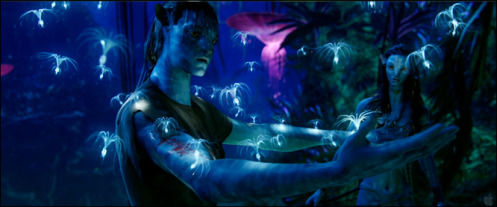Text
The use of technology in society has often been characterised in terms of what it is used to say. Belonging to this school of thought is Director Steven Spielberg, who argues that ‘the medium is not the message’ when it comes to film (in Boucher 2011). In contrast, Marshall McLuhan (1964) argued that the way a medium is used is more important than what the medium is used to say. Often these two theories are presented in needless hostility. This essay will argue that rather than being strictly mutually exclusive theories, it is a combination of the two theories through which certain films are best examined. To explore this argument, this essay will use James Cameron’s Avatar (2009) to examine how the digitalisation of the medium of film can be simultaneously examined as both meaning-laden and meaning-obfuscating, leaving the distinction between medium and message sufficiently blurred.
1 note
·
View note
Text
The Medium and the Message
Firstly, to understand both theories. For McLuhan (1964), the message of any medium is the change it introduces into human affairs. Film is therefore a result of augmented mechanisation, allowing the development of moving images which are digested by audiences. The technological structuring of film and the space it provides is the message of the medium of film. Therefore, for McLuhan, the content of the medium is a petty distraction which we privilege over the real message which is the effects brought about using the medium itself:
0 notes
Quote
Our conventional response to all media, namely that it is how they are used that counts, is the numb stance of the technological idiot. For the 'content' of a medium is like the juicy piece of meat carried by the burglar to distract the watchdog of the mind
(McLuhen 1964, 20)
0 notes
Text
The innovations of digital cinema thus signify the advancement of the medium and the message. The specific technologies afforded to digital filmmakers thus signify more to McLuhan than the stories these technologies are used to tell.
0 notes
Text
Contrary to McLuhan, much of film studies has focused on the content of the medium, choosing to examine which stories are told and how they are told. The content of filmic stories has received considerably more research than the means through which they are told, but this is not due to a misallocation of scrutiny. With the importance of politics and representation in the modern age, the stories told in film are essential to understanding the anxieties and beliefs of the cultural sphere. Thus, characters and plot carry their own important message which can be analysed. However, while significant, it is equally as significant to examine what technology in film enables filmmakers to do. Thus, rather than relegating technology as simply a means through which the message can be told (Spielberg in Boucher 2011) or ridiculing the content of film as inconsequential (McLuhan 1964), there needs to be an understanding of the strengths and weaknesses provided by both arguments. Because each party neglects to consider the nuances afforded by the other, neither adequately encompasses the complexities of the digital cinema. It is thus, a mixture of both concepts which provides the best lens of analysis and which I will use to examine Avatar.
0 notes
Text
Avatar and its Ecological Message
Avatar is the highest grossing film of all time, earning nearly $2.8 billion since its release (Box Office Mojo 2018). Marketed as a 3-D blockbuster, Avatar has been hailed a masterpiece for its ground-breaking digital effects and aesthetic, winning Academy Awards for its cinematography, visual effects and art direction. Cinematic accolades aside, Avatar has been described as Cameron’s first explicitly political movie (McVeigh and Kapell 2011) and consequently there has been significant discussion and critique of Avatar’s politics in terms of gender (Nesbitt 2016), disabilities (Fore 2011), Environmentalism (Erb 2014) as well as colonialism and patriotism (Schuller 2013; Sheppard 2015; Veracini 2011). First and foremost, Avatar is a film about ecology and the destruction of the environment at the hands of humans bent on domination. Pandora’s lush colour palette is almost oversaturated when compared to the dull browns and greys of dystopic Earth (See Fig 1 and 2). Through the use of 3D, the film places emphasis on experience, both of the protagonist Jake and the audience. Pandora’s beauty is made to be seen, heard and most importantly felt by the audience using subjective shots and the depth realism brought through 3D:
0 notes
Quote
Avatar uses its 3-D to create the experience of moving into and navigating through an ornately rendered deep-space cinema. . . . The film is thus as much about the spectator’s training regimen as it is about Jake’s
(Levitt in Schuller 2013, 185)
0 notes
Text
The sheer beauty and naturalness of Pandora implies that must be protected from the corruption of the RDA who seek to exploit its rich mineral stores. Pandora must be saved because it is Earth prior to human industrial corruption. Thus, the film uses its digital technology to strengthen its ecological message. Technology gives audiences a subjective, sensory experience which promotes an emotive connection to the environment shown on screen.
0 notes
Text
The film also strengthens its ecological stance outside of its diegetic world. The DVD release of Avatar was on Earth Day and purchasers of the DVD were encouraged to join a reforestation project to plant trees around the world (Erb 2014). Similarly, a week before the release of Avatar in cinemas, the film’s official YouTube channel released a first look at the world of Pandora, narrated by Sigourney Weaver. With many shots of Pandora’s creatures through foliage and behind cervices, a documentary style is invoked, adding to the realism of Pandora. This pseudo-documentary, purely designed to give information about the animals and people of Pandora, not about the plot, creates a feasible world outside of the narrative’s diegesis. This realism brought about through other mediums helps to stress the ecological message of Avatar.
0 notes
Video
youtube
The Pseudo-Documentary gives Pandora realism outside of the diegetic world of the film.
0 notes
Text
Avatar’s Settler-Colonial Underpinnings
Secondly, Avatar must be examined in terms of its attempts at critiquing colonialism and patriotism. While Avatar challenges colonist/native binaries by positioning audiences to align with the native people of Pandora (the Na’vi), it has simultaneously received much criticism for its use of the ‘white saviour’ storyline and the trope of the colonist man/native woman love story. Avatar tries to sentimentalise these tropes by Jake’s political allegiance and sympathies with the Na’vi (Schuller 2013; Veracini 2011). But this attempt only plays further into colonist theories of good intentions redeeming deplorable actions. For it is Jake who eventually leads the Na’vi into battle, claiming Pandorian culture and lifestyle as his own. In fact, Jake masters skills beyond the abilities of the Na’vi people. His bonding with the great leonopteryx allows him to become the sixth Toruk Makto (a great Na’vi warrior) in the history of Pandora and ascends him to leader of the Na’vi people. It is in this moment, Veracini (2011, 362) argues, that the Indigenous People of Pandora and their polities become truly subordinate to the leadership of the ‘civilised’ saviour. Their own leadership is replaced by a coloniser who has ‘out-Na’vied’ them due his ability to adapt and progress like ‘civilised’ society. Neatly summarised, Jake:
2 notes
·
View notes
Quote
makes this place his home, finds a new purpose, compels the indigenous people to recognise that he belongs, that he is entitled and that he is boss, and finally expels those who have not committed to the new place
(Verancini 2011, 365)
0 notes
Text
Avatar therefore enacts a thoroughly settler colonial story, in which identification remains sympathetic to the coloniser and his heroic work to ‘save’ the Indigenous people of Pandora. This is where it remains important to examine the content of film, regardless of its medium. To ignore this discourse, is it ignore the problematic representation of settler-colonial societies and how misguided attempts at reconciliation are often sentimentalised.
0 notes
Text
The Medium Usurps the Message?
Whilst Avatar engages special effects to engage viewers in its content, to what extent is the content lost in all its grandeur? The digital technologies of Avatar were a huge drawcard, with its 3D aspect being heavily emphasised in its promotion and marketing (Fig 3). Similarly, instead of focusing on the now campy ‘pop-out’ effect of the early days of 3D technology, Avatar gave greater attention to depth-realism, expanding the world for the viewer (Ross 2012). Avatar intended to be immersive for the viewer, and the world of Pandora is supposed to be felt and experienced not just seen (Furze and Brereton 2014). The choice to shoot Avatar in 3D is an intentional desire to give the viewer a more immersive cinema experience. But what does this medium take away from content of Avatar? Are the digital effects too mesmerising? Does the medium usurp the message? There is a consensus amongst reviews of Avatar that its special effects truly are what make it special, rather than its plot or overall message (Travers 2009; Pulver 2009; French 2009). Whilst deeper scholarly analysis into Avatar has been done to discuss the complexity of its messages, on the surface it remains remembered as a pioneer in 3D and digital technology (Power 2016; Child 2017). In this sense, in the case of Avatar, the medium is the message, even if it is unintentionally so.
0 notes


